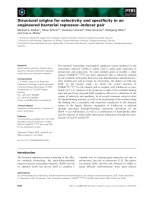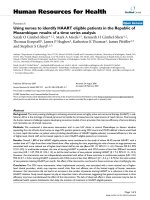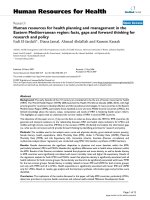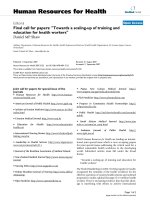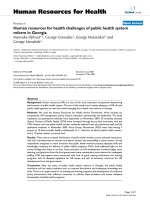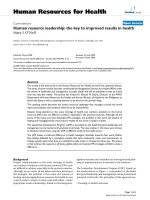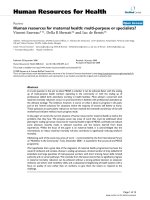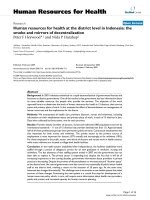báo cáo sinh học:" Human resources for health and decentralization policy in the Brazilian health system" docx
Bạn đang xem bản rút gọn của tài liệu. Xem và tải ngay bản đầy đủ của tài liệu tại đây (245.09 KB, 6 trang )
RESEARCH Open Access
Human resources for health and decentralization
policy in the Brazilian health system
Celia Regina Pierantoni
1,2,3*
and Ana Claudia P Garcia
1,2
Abstract
Background: The Brazilian health reform process, following the establishment of the Unified Health System (SUS),
has had a strong emphasis on decentralization, with a special focus on financing, management and inter-
managerial agreements. Brazil is a federal country and the Ministry of Health (MoH), through the Secretary of
Labour Management and Health Education, is responsible for establishing national policy guidelines for health
labour management, and also for implementing strategies for the decentralization of management of labour and
education in the federal states. This paper assesses whether the process of decentralizing human resources for
health (HRH) management and organization to the level of the state and municipal health departments has
involved investments in technical, political and financial resources at the national level.
Methods: The research methods used comprise a survey of HRH managers of states and major municipalities
(including capitals) and focus groups with these HRH managers - all by geographic region. The results were
obtained by combining survey and focus gro up data, and also through triangulation with the results of previous
research.
Results: The results of this evaluatio n showed the evolution policy, previously restricted to the field of ‘person nel
administration’, now expanded to a conceptual model for health labour management and education– identifying
progress, setbacks, critical issues and challenges for the consolidation of the decentralized model for HRH
management. The results showed that 76.3% of the health departments have an HRH unit. It was observed that
63.2% have an HRH information system. However, in most health departments, the HRH unit uses only the payroll
and administrative records as data sources. Concerning education in health, 67.6% of the HRH managers
mentioned existing cooperation with educational and teaching institutions for training and/or specialization of
health workers. Among them, specialization courses account for 61.4% and short courses for 56.1%.
Conclusions: Due to decentralization, the HRH area has been restructured and policies beyond traditional
administrative activities have been developed. However, twenty years on from the establishment of the SUS, there
remains a low level of institutionalization in the HRH area, despite recent efforts of the MoH.
Background
Brazil is a federal republic with 27 States and more than
five thousand cities (if municipalities are included). Each
state and their cities hav e political and administrative
autonomy in the management of public policies. The
National Health System consists of a funded public sec-
tor, the Unified Health System (SUS), and a private sec-
tor, comprising several prepayment mechanisms (e.g.
health insurance) and o ut-of-po cket financing. The SUS
is defined in the 1988 Brazilian Constitution as being
founded on the principles of universal coverage, integral
care and equity, with the aim of providing free access to
health care for the whole population. It provides exclu-
sive coverage for 78.8% of the Brazili an population. The
remaining 21.2% of the population–covered by a supple-
mentary system–also have the right to acce ss services
provided by SUS. Furthermore, the SUS is also responsi-
ble for the provision of services such as health surveil-
lance, disease control and health industry regulation [1].
There are about 2 200 000 healthcare workers, most of
them employed by the public sector, with many at the
municipal level (Table 1).
* Correspondence:
1
Social Medicine Institute of Rio de Janeiro State University (IMS/UERJ), Rio
de Janeiro, Brazil
Full list of author information is available at the end of the article
Pierantoni and Garcia Human Resources for Health 2011, 9:12
/>© 2011 Pierantoni and Garcia; licensee BioMed Central Ltd. This is an Open Access article distri buted under the t erms of the Creative
Commons Attribution License ( which permits unrestricte d use, distribution , and
reproduction in any medium, provided the original work is properly cit ed.
Although unified coordination is expected at every
level of the administratio n (federal, state and municipal),
in terms of responsibilities and prerogativ es in the for-
mulation of sectoral policies, the various contextual,
organizational and economic conditions have influenced
the modes of implementation and sustenance of the
SUS.
The Brazilian health reform process put great empha-
sis on decentralization, transferring de cision making
authority to sub-national levels. Such decentralization
requires po litical and administ rative organizational
structures to manage public policies with legally con-
ferred, socially accepted, financial and administrative
responsibilities.
Therefore, states and municipalities were given more
responsibility in the development and implementation of
human resources for health (HRH) policies following the
reform, which allowed the formation of a ‘new’ arrange-
ment of the health labour management and education
area, at all levels. This new set-up can be defined as a
set of activities that involve the planning, funding,
recruitment, deployment, allocation and train ing of
health workers. As a whole, this set of activities is aimed
at improving health care quality and regulatory mechan-
isms (through cooperation between professional councils
and associations, public and private health education
institutions and civil society.
The reform brought policies to change the organiza-
tion, operation and management of services, modifying
working conditions and redefining roles and models of
managing human resources (HR). In this context, the
political and administrative decentralization process
included a key component: providing greater freedom of
choice between systems and services, which implied
redefining and strengthening human resources manage-
ment, especially in public services.
The consensus around these ideas emerged in the
1970s, with the exhaustion of the paradigm of the cen-
tralized public sector. In the HRH area, some functions
which are decentralized are relat ed to employment (hir-
ing and firing, nature of tenure, defining the compensa-
tion package); to management (transfers, promotions
and sanctions), and to skill-mix and training [2].
According to Fleury [3], the 1988 Brazilian Constitution
broke new ground by building a democratic institution,
focusing too much, however, on the public perspective, in
contrast to the new global order, guided by globalization
and neoliberalism. While other countries were already
affected by the wave of neoliberal market logic as the guid-
ing model of social reform, in Brazil the changes of the
1980s were marked by the decentralization of policies and
services and the pursuit of a universal system of social pro-
tection, including health care.
The tendency to concentrate fiscal resources at the
federal level was reversed with the political, administra-
tive and financial decentralization. The mec hanism for
transferring federal funds for sub-national levels was
also amended, and at the end of the 1980s more
resources started to be t ransferred automatically, based
on population and per capita income.
As pointed out by Melo [4], there is a strong polariza-
tion in the publi c debate in Brazil about this issue.
Some consider the process as virtuous as, in addition to
a more robust democracy, the strengthening of sub-
national levels of go vernment should improve allocating
efficiency in the government system. Others, however,
consider that states and municipalities are loci of
patronage and inefficiency, so their empowerment
results in ungovernableness. Furthermore, it is also
argued that some efforts to stabilize the federal adminis-
tration have brought fiscal irresponsibility to the lower
levels.
It has been also noted that a positive factor of decen-
tralization is that, theoretically, it involves the commu-
nity in the promotion and management of services,
allowing a simplificatio n of procedures, facilitating the
purchase of supplies and equipment, adaptation of ser-
vices to local needs and improving HR administration,
with greater accountability. In a suitable process of
decentralization, there are changes at all levels of
responsibility, reaching the smallest units and the most
peripheral levels of decision making. However, the lack
of institutional capacity at the local level and of clear
instruments to coordinate and consolidate nationwide
policies may compromise the advantages of decentraliza-
tion [5].
Within this context of transition from a highly politi-
cally and economically centralized system to a decentra-
lized system, the municipal administrations started to
play a k ey role in the health arena. Noronha et all [6]
point out that, as a way to achieve certain goals, decen-
tralization was the only organizational guideline of the
SUSthatdidnotgoagainsttheso-called‘neo-liberal
ideas’ of strengthening the right to health and opposing
the expansion of size of the state and
However, Pierantoni at al. [7], argue that the decentra-
lization of health services in Brazil did not result auto-
matically in the transfer of management capacity for
municipal levels. In fact, it worsened chronic problems
Table 1 Health employment by administrative level,
Brazil, 2002.
Federal Estate Municipal Total public
sector
Total private
sector
Number 96 064 306 042 791 377 1 193 483 987 115
% 4.4 14.0 36.3 54.7 45.3
Source: IBGE, Pesquisa Assistência Médico-Sanitária, 2002.
Pierantoni and Garcia Human Resources for Health 2011, 9:12
/>Page 2 of 6
and, in accordance with the political demands, forced
the municipal health managers to develop several differ-
ent solutions and special administrative arrangements,
including changes in the system, which generate con-
straints and legal challenges.
Vianna and Machado [8] show that the recent experi-
ence of forming a new political agreement at federal
level revealed the importance of the federal administra-
tion in the for mulation and regulation of public poli-
cies–something that it not incompatible with sectoral
decentralization policies.
In Brazil, the i mplementation of the public health sys-
tem was supported by two different approaches. The
first one is the federal centralization that made a decen-
tralization policy possible, in which the federal adminis-
tration has the author ity to define standards, financial
incent ives and other tools of national ind uction. This is
possible because in the Brazilian health system there is a
federal pact to cooperation among federal level, states
and municipalities. The second approach was the sup-
port of social and political actors of highly organized
sub-national authorities and federal managers.
As Dal Poz [9] h as observed, in relation to the HRH
policies, there was an almost automatic mirroring of
what was established at the federal level by the other
administrative levels; and a lack of innovation and adop-
tion of policies that responded to specific problems.
Even in municipalities with more innovative health poli-
cies, the behaviour of policy makers and health man-
agers is considerably conservative. According to Dal
Poz, in the late 1990s, there was a need to establish
national policies that incentivized regional and local pol-
icy-makers and decision-makers to adopt policies better
suited to their needs.
To address some of these challenges in the HRH area,
in 2003 the Ministry of Health (MoH) created the
National Secretary of He alth Labour Management and
Education (SGTES). Since then, the federal government
has been formulating policies to guide health labour
managemen t, education, training and professional prac-
tice and regulation. This paper assesses whether the
process of decentralizing human resources for health
(HRH) management and organization to the level of the
state and municipal health departments (SES and SMS)
has involved investments in technical, political and
financial resources originally allocated to health labour
and education management at the national level (MoH).
Methods
We combined quantitative and qualitative methods to
bett er capture all dimensions of this issue. According to
Minayo [10], there is no opposition between quantitative
and qualitative data, but rather complementarity,
reflecting the dynamic interaction within the re ality they
represent, eliminating any dichotomy.
Building on previous work [11,12], we conducted
some workshops with researchers, master students,
graduate trainees and HR consultants to develop a sur-
vey, with 74 questions, divided into five sections:
1. Characterization of health departments and
managers.
2. Managers’ level of knowledge about SGTES.
3. Health labour management policies.
4. Education management policies.
5. Managers’ opinions regarding SGTES policies.
A pre-test was carried out in consultation with HRH
management experts. Once the changes outlined and
recommended in the pre-test were done, we dis semi-
nated the research to increase the ma nagers’ awareness
and participation.
From the experience gained in previous research a
computer-assisted telephone interview (ETAC) method
was used. The data collection phase lasted five months,
bein g completed in February 2008, with 253 HRH man-
agers of 27 state health departments (SES) and 206 large
cities (SMS, including 23 capitals).
After the ETAC, the database was cleaned and verified
for c onsistency of the informat ion collected. The
responses were processed using specific software, Sphinx
[13], allowing direct tabulation and st atistical analysis of
collected data.
The ‘cut-off point’ question was whether the creation
of SGTES had generated or influenced changes in the
departments surveyed (question 17). Thereafter, we ana-
lyzed the data obtained by comparing answers to the
question of whether there were changes fol lowing the
creation of SGTES with questions that examined the
influence of federal level policy guidelines in HRH man-
agement in sub-national governments.
When analyzing results, we identi fied information
deserving in-depth or further research, due to its impor-
tance to–or its relationship with–the our central
research theme. Based on this, we decided to perform
focal groups with HRH managers from five geographic
regions of the country.
The focal groups were carried out from 6 March to 10
April 2008, conducted by two researchers. One was the
moderator, explaining the purpose and format of the
meeting so that participants knew what to expect.
Another researcher played the role of rapporteur,
recording the discussion through voice recording and
tak ing notes regarding the content and behavior of par-
ticipants. The information was systematized by region,
then translated into a general framework noting the
Pierantoni and Garcia Human Resources for Health 2011, 9:12
/>Page 3 of 6
prevalent ideas or themes. This material was then
further analyzed.
From the results ob tained so far, a comparative study
was carried out based on the results of the previous sur-
vey conducted by the National Council of State Health
Departments (in 2004) [11], in the cities and capitals
with more than 100 000 inhabitants [12]. We were then
able to identify progress made, and setbacks and chal-
lenges encountered, indicating the trends in the SUS
decentralization of HRH management.
Results and disc ussion
From the broad set of health labour and education man-
agement policies assessed, we present in this paper the
results of the analysis of the strategies considered most
relevant to HRH decentralization, and to the structuring
and organization of HRH management at state and
municipal levels.
Existence of an HRH unit
It was observed that 76.3% of the health departments
have a human resources for health unit of some kind, as
shown in Table 2. Most of them followed the federal
model (SGTES), covering two areas: health labour and
health education management.
Almost half (48%) of the health departments have
changed since 2003, following the establishment of the
HRH unit (SGTES) at the Ministry of Health.
Organizational changes within the HR units at SMS
and SES due to the policies implemented by SGTES
were reported by 48% of the respondents. One of the
major changes, mentioned by 62% of participants, was
the participation in technical cooperation projects pro-
posed by SGTES.
Health labour management policies
Among the health labour management activities, the
study looked at the career path proposed by the federal
level, calling for a ‘unif ied’ career that would be similar
at all levels. It was observed that 47.8% do not have any
career path plans, particularly at municipal health
depar tments outside the capitals; about 20% have a spe-
cific career plan for the health division and 29% have a
plan for all civil service workers.
Another strategy analysed in the study was the Labour
Negotiation Program, with about 27% of the managers
involved. This program is an important tool for the SUS
health labour management, ensuring participation of
employees, employers, managers and administration
representatives. It allows independent discussions on
several aspects of the SUS labou r relations and working
conditions, such as hours of working, wage and career
path.
The study also assessed the program for reducing the
number of jobs with no labour rights or social protec-
tion (e.g. without social security, weekly paid rest period,
vacations, etc.). It was observed that 42% of managers
are not aware of this program. 17% of the managers sta-
ted that there was no precarious work in their context.
Another initiative evaluated in this study was the pro-
gram for qualification and modernization of HRH
decentraliz ed units (nickname PROGESUS - Progr am of
Qualification a nd Strengthening t he Labour and Educa-
tion Management in the Unified Health System). This is
the best known program among the managers (at 77%).
It aims t o modernize the health departments through
training of health professionals on HRH management,
development of a national health workforce information
system and purchasing equipments.
Although the study shown that 63.2% have an HRH
information system (Table 3), the focal groups identified
that many health departments had only the payroll and
administrative records as information sources for
management.
Although useful, these two sources are centralized in
municipal administration, especially in the North, Mid-
west and Nort heast regions of Brazil, limiting the access
and use of the data. This problem was aggravated in
many places by the lack of local HRH structure.
In this context, HRH information is fragmented, insuf-
ficient and depends on rudimentary processes for data
collection and analysis, making health workforce plan-
ning and recruitment difficult (Table 3).
Health education management policies
Among the SGTES proposals for linking health and
training, it is worth mentioning the training and
Table 2 SMS/SES with HRH unit, Brazil, 2008.
HRH unit number %
yes 193 76.3
no 57 22.5
no response 3 1.2
TOTAL 253 100.0
Source: Pesquisa Gestão do Trabalho e da Educação em Saúde.
ObservaRH/IMS-UERJ. Brazil, 2008.
Table 3 HRH information system, Brazil, 2008.
HRH information system capitals SES SMS TOTAL %
yes 21 21 118 160 63.24
no 2 5 73 80 31.62
don’t know 0 0 7 7 2.77
no response 0 1 5 6 2.37
TOTAL 23 27 203 253 100.00
Source: Pesquisa Gestão do Trabalho e da Educação em Saúde. ObservaRH/
IMS-UERJ. Brazil, 2008
Pierantoni and Garcia Human Resources for Health 2011, 9:12
/>Page 4 of 6
specialization program of the SUS health workers,
undertaken through agreed partnership activities
between educational institutions and state and munici-
pal health departments.
These partnerships may be technical, financial or
operational and take the form of specializations, intro-
ductory or regular/specific training programs, and also
internships. These types of partnerships are found in
67.6% of the departments. It was also observed that the
main types of partnership consist of specialization
courses (61.4%) and internships (56.1%), as shown in
Table 4.
The Program of Permanen t Education in health is a
professional training program for health workers, which
aims to produce changes in professional practices. It
was o bserved that 46% of the health departments parti-
cipate in this program, promoting training, specialization
and postgraduate programs in different areas.
The Health Professional Education Reorientation Pro-
gram is an initiative aiming to close the gap between
health professional education and primary health care
needs in Brazil. The p rogram involves three years of
financial support for projects, with a potential for trans-
forming the current education model. The processes o f
reorientation o f education in the ‘Pró-Saúde’ (Pro-
Health) program are organized along thr ee axes: theore-
tical direction, practice scena rio and pedagogical direc-
tion. Initially, the program included medicine, nursing
and dentistry. In the second phase, other healthcare pro-
fessionals are i ncluded. However, the study showed that
60% of HRH managers are not aware of the program.
Conclusions
The decentralization of the health system in Brazil was
established by the Federal Constitution and assured by
specific legi slation and norms. Considering the size and
geographical and political diversity of the country, it is
no surprise that the decentralization process did not
develop at t he same speed everywhere, nor in a uniform
manner.
As shown in the study, the area of human resources of
the state health departments (SES) and municipal health
departments (SMS) of large cities has been, over time,
restructuring and developing actions that g o beyond the
traditional administrative activities. However, after two
decades of the SUS h aving been implemented, there is
still a low management capa city in the area of HRH, as
demonstrated by low-quality management and the lim-
ited use of management tools to support decision
making.
This study shows that in HRH management and inter-
sectoral relations, the health workers in Brazil make up
a contingent of professionals influenced by different sys-
tems of policy formulation, with autonomy, direction
and particular concerns not governed by sectoral poli-
tics. Therefore, any HRH policies should also involve
other areas, such as the ministries of education and
labour as well as legislative and judiciary bodies.
The results of this evaluation show the evolution of
policy previously restricted to the field of ‘human
resources’ (as inputs). It has now expanded to a concep-
tual model for labour management and health educa-
tion, identifying progress and setbacks, critical issues
and challenges for the consolidation of decentralized
model for HRH management.
Overall the results of this analysis show:
• The key role played by the State Health Depart-
ment (SES) in n egotiation and technical cooperation
with the municipal health departments (SMS) with
respect to the design and development of effective
health labour and education management.
• The central role of the federal agency (SGTES) in
providing HRH policy incentives through the use of
financial, administrative and technical resources.
• The need fo r the federal agency (SGTES) to moni-
tor and evaluate HRH policies, especially when
adapting to different conditions; and when looking
for innovations, particularly in health education.
Acknowledgements
The survey was conducted by the Human Resources for Health Observatory
- Workstation of Social Medicine Institute, State University of Rio de Janeiro
(IMS/UERJ) with the financial support of the Ministry of Health
Author details
1
Social Medicine Institute of Rio de Janeiro State University (IMS/UERJ), Rio
de Janeiro, Brazil.
2
Human Resources for Health Observatory - Workstation of
IMS/UERJ, Rio de Janeiro, Brazil.
3
Collabourating Center of the Pan-American
Health Organization/World Health Organization (PAHO/WHO) for Health
Workforce Planning and Information, Brazil.
Authors’ contributions
Both authors participated equally in all stages of preparation of this paper.
They read and approved the final manuscript.
Competing interests
The authors declare that they have no competing interests.
Received: 31 December 2010 Accepted: 17 May 2011
Published: 17 May 2011
Table 4 Mechanisms of technical cooperation between
SMS/SES and health educational institutions, Brazil, 2008.
Cooperation mechanism Number %
Internship 96 56.14
Specialization training course 105 61.40
Regular training course on specific thematic programs 66 38.60
Induction training courses 57 33.33
Source: Pesquisa Gestão do Trabalho e da Educação em Saúde. ObservaRH/
IMS-UERJ. Brazil, 2008.
Pierantoni and Garcia Human Resources for Health 2011, 9:12
/>Page 5 of 6
References
1. Estratégia de cooperação. WHO:[ />cooperation_strategy/ccsbrief_bra_09_po.pdf].
2. Vujicic M, Ohiri K, Sparkers S: Working in Health: financing and managing the
public sector health workforce Washington D.C: The World Bank; 2009.
3. Fleury S: Brasil: uma agenda de reformas. RAP: Revista de Administração
Pública 2004, 38(6):1085-94.
4. Melo MA: Crise Federativa, Guerra Fiscal e “Hobbesianismo Municipal":
efeitos perversos da descentralização? São Paulo em Perspectiva 1996,
10(3):11-20.
5. Novick M: Desafíos de la Gestión de los Recursos Humanos en Salud:
2005-2015 Washington D.C: OPS; 2006.
6. Noronha J, Lima L, Machado CV: O Sistema Único de Saúde. In Políticas
e Sistema de Saúde no Brasil. Edited by: Giovanella L, et al. Rio de Janeiro:
FIOCRUZ; 2007:.
7. Pierantoni CR, Varella TC, França T: Recursos humanos e gestão do
trabalho em saúde: da teoria para a prática. In Observatório de Recursos
Humanos em saúde no Brasil: estudos e análises. Volume 2. Edited by: Barros
AFR, et al. Brasília: Ministério da Saúde; 2004:51-70.
8. Vianna ALA, Machado CV: Descentralização e coordenação federativa: a
experiência brasileira na saúde. Ciência e Saúde Coletiva 2009,
14(3):807-817.
9. Dal Poz MR: Entre o prescrito e o realizado: estudo sobre a implantação
do SUS no Estado do Rio de Janeiro e sua repercussão na política de
recursos humanos em nível municipal. PhD thesis Universidade do Estado
do Rio de Janeiro, Instituto de Medicina Social; 1996.
10. Minayo MCS, Deslandes SF, Neto OC, Gomes R, (org): Pesquisa Social: teoria,
método e criatividade Petrópolis: Vozes; 2001.
11. Conselho Nacional de Secretários de Saúde (Brasil): In Estruturação da área
de recursos humanos nas Secretarias de Saúde dos Estados e do Distrito
Federal. Volume 1. CONASS Documenta Brasília: CONASS; 2004.
12. ObservaRH/IMS/UERJ: Capacidade gestora de recursos humanos em
instâncias locais de saúde em municípios com população superior a 100 mil
habitantes Rio de Janeiro, IMS/UERJ; 2004. Relatório Técnico; 2011.
13. Sphinx Brasil: Softwares Sphinx 5.[ />lang=po&lone=softwares<wo=apresentacao].
doi:10.1186/1478-4491-9-12
Cite this article as: Pierantoni and Garcia: Human resources for health
and decentralization policy in the Brazilian health system. Human
Resources for Health 2011 9:12.
Submit your next manuscript to BioMed Central
and take full advantage of:
• Convenient online submission
• Thorough peer review
• No space constraints or color figure charges
• Immediate publication on acceptance
• Inclusion in PubMed, CAS, Scopus and Google Scholar
• Research which is freely available for redistribution
Submit your manuscript at
www.biomedcentral.com/submit
Pierantoni and Garcia Human Resources for Health 2011, 9:12
/>Page 6 of 6

